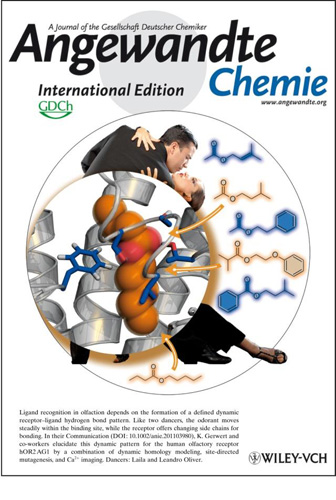Banana, mango or apricot - telling these smells apart is no problem for the human nose. An interdisciplinary team of researchers at the CAS-MPG Partner Institute for Computational Biology (PICB), the Ruhr-University Bochum and the Charité Berlin (both in Germany) has uncovered how the olfactory organ distinguishes such similar smells. The scientists were the first to shed light on the dynamics of the three-dimensional structure of the binding site of an olfactory receptor. In so doing, they also found a characteristic pattern of hydrogen bonds between odorant and receptor, which accounts for the specificity of the olfactory sensors. Using computer simulations, the PICB team was able to predict whether odorant molecules activate a certain receptor or not. The study was chosen as cover story of the journalAngewandte Chemie International Edition.
The human nose has about 350 different types of olfactory receptors, each specializing in one or a few smells. The receptor is like a door lock which can only be opened by the right key. How the lock is exactly constructed was previously unknown. To solve the puzzle, Dr. Steffen Wolf and Prof. Dr. Klaus Gerwert set out by creating a computer model of the human olfactory receptor for the smell of apricots. In the model, theymutated several components (amino acids) in the binding site of the protein and predicted whether these receptor variants bind apricot fragrance or not. Dr. Lian Gelis, Prof. Dr. Eva Neuhaus, and Prof. Dr. Hanns Hatt in Germany then verified these predictions using “Ca2+-imaging” on the receptors in the physiological system.
In this way, the researchers showed how the binding site has to be structurally constituted so that the apricot fragrance activates the receptor. Using molecular dynamics simulations, they then analyzed the two binding partners in greater depth. They found that, in the dynamic interplay of the interaction between receptor and odorant molecule, specific chemical bonds, called hydrogen bridges, form and separate. The molecules behave like in a tango, where the female dancer constantly separates from her partner and joins him again at another point. The receptor uses this dynamic hydrogen bonding pattern to distinguish between activating and non-activating odours.
The researchers established how many molecular junctions the interaction partners have to form in order for a smell to activate an olfactory receptor. They also managed to specifically manipulate a receptor protein in the model and in the experiment so that it detected papaya fragrance instead of apricot fragrance. Since olfactory receptors not only occur in the nose, but also in many other tissues in the human body, for example in the prostate, in sperm, and in the intestines, the results may help to develop novel therapeutic approaches for illnesses associated with these tissue.
AUTHOR CONTACT:
Klaus Gerwert
CAS-MPG Partner Institute for Computational Biology, Shanghai Institutes for Biological Sciences, Chinese Academy of Sciences, Shanghai, China
Phone: 86-21-54920465; Email:gerwert@picb.ac.cn
(PICB)
The Tango of Odorants: Olfactory Recognition via a Dynamichydrogen Bond Matrix


